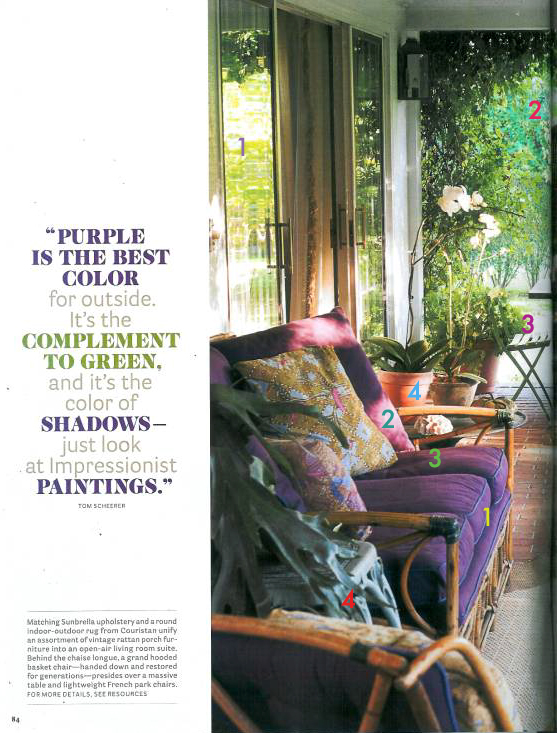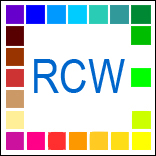Aleta sent me this picture from House Beautiful to comment on.

Note: Remember all primary colors on my color wheel are transparent pigments.
#36 yellow-yellow-green is opposite #18 ultramarine violet.
As the yellow-yellow-green (sunlit green) turns greener until it's at full green #31. The opposite of #31 green is magenta #13.
#16 dioxazine purple is opposite yellow-green #34.
THE OPPOSITE OF GREEN IS NOT PURPLE OR RED,
IT'S MAGENTA, BETWEEN PURPLE AND RED.
PURPLE IS OPPOSITE YELLOW-GREEN, A COLOR 30º AWAY FROM GREEN.
I put similar numbers in the image to show their opposition colored objects.
The ad says purple and green make shadows, purple and green make shadow colors in the distance where the color becomes bluer. In the foreground, green's shadows are made by adding magenta. Both of the sets of colors are in his photo. So either he's blowing smoke, really lucky or he made a cheap set of upholstery look good with very little money and a good photography.
Don
Aleta: Ok,
I understand all the opposite, numbers/colors. I use the real color wheel with all the design images I study and critique.
The main reason I sent the image was so that you could see the type written info stating that the complement to green is purple.
I thought you might be interested in that.
I thought overall the image was soothing the eyes and looked pretty good.
After more thought and insight, yes I agree with you on the cheap furniture.
I appreciate all your feedback as well.
I see things that I would have done differently.
I would make sure the split compliments were correct!
His split combinations were off.
He went too yellow on the pillows for it to be a true split compliment.
Don: He went with too warm of a yellow, a nice cool yellow-yellow-green in it's place would have looked nice. I agree with you, that pillow is a mistake. I do want to agree with the designer because purple does look good outside because most of the green plants you see are yellow-green to yellow-yellow green which are opposite purple to blue purple.
I am a perfectionist .... so I would absolutely change some things.
I don't like things to look too contrived either. Then there is no personality to the design.
I am still learning, but you sure do have an eye for design and quality!!
Let me get some food.
I am running on shear determination at this point in time.
I'll get back to you.
Later.... Aleta

 Home
Home

 Help
Help

 Search
Search

 Login
Login

 Register
Register

 Broadcast Message to Admin(s)
Broadcast Message to Admin(s)

 « Home
« Home  ‹ Board
‹ Board  Top of this page
Top of this page 
 Pages: 1
Pages: 1

